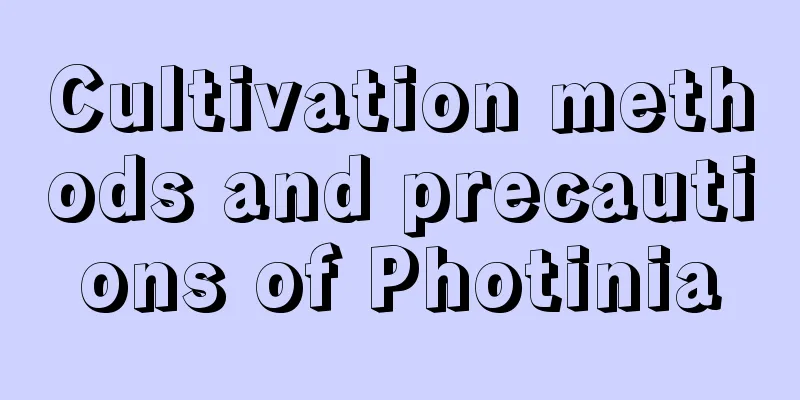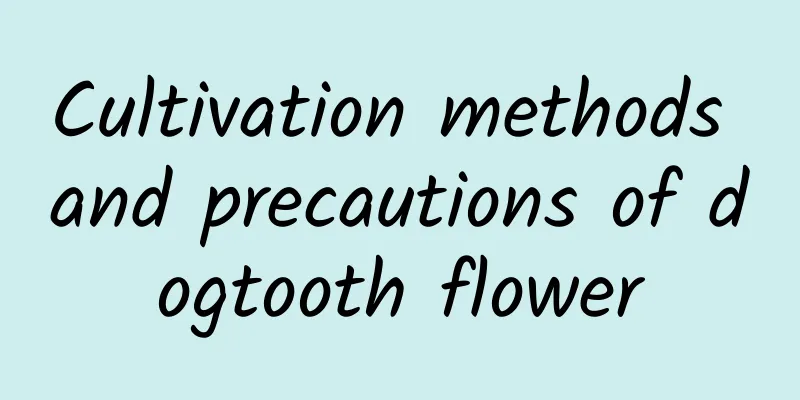Cultivation methods and precautions of Photinia

|
In recent years, it has been found that many flower lovers like Chinese photinia more and more, not only because it is a bonsai, but mainly because it has a magnificent feeling when placed at home. The whole trunk is simple and majestic, the leaves are lush green, and it has excellent ornamental effect. Let’s talk about the cultivation methods and precautions of Chinese photinia. 1. Basic maintenance skills of Photinia Habits: Prefers mild and humid weather and is not very adaptable to cold environments. It can tolerate drought, survive in watery environments, and grow on poor soil. It also has strong resistance to pruning. Therefore, Photinia pyralis is an easy plant to maintain. Temperature: The photinia is sensitive to cold, so in winter, the indoor temperature needs to be maintained above 5 degrees Celsius and air circulation must be ensured. If the temperature is too low, a protective covering can be used to provide additional warmth. When the temperature rises above 25 degrees Celsius in summer, it should be placed in a well-ventilated place to prevent excessive growth due to high temperatures. Soil: The photinia is not picky about the type of soil. It can grow normally in acidic, neutral or lime- containing soil. However, if you want it to grow more luxuriantly, it is best to choose soil that is similar to its original growth environment. Digging stumps: A critical first step in obtaining excellent bonsai material is selecting the right stump. Once they find the ideal pile material, many people can't wait to take it home immediately. If you are familiar with the maintenance techniques and habits of the photinia, then you will definitely know how to deal with it. However, for most people, we still recommend that the best time to dig be determined based on local climate conditions. 2. Maintenance of downhill piles of Photinia Preventing re-budding: Generally, after transplanting the photinia, there is no need to rush to wrap it with a shade net to prevent the buds from appearing prematurely. Although germination may be slightly delayed, this practice helps ensure that the root system develops first, resulting in a balanced nutrition that increases the survival rate of the plant. To increase soil temperature and stimulate root growth, place a shade cloth over the soil surface. Just spray the trunk with water regularly to maintain humidity. For those enthusiasts who wish to promote germination, it is recommended to gradually remove the shade net, such as making a few small holes in the shade net to allow the plants to gradually adapt to the external environment. Killing stumps and planting: Arrange the stumps and decide which branches to keep based on their shape. After completing the pruning, you can apply a solution of carbendazim or thiophanate-methyl diluted to 800 times to the wounds on the branches, or soak the roots and wrap the broken parts with aluminum foil to seal them. Doing so can not only reduce water loss, but also prevent the wound from being infected by diseases. After planting, you need to water it thoroughly. Watering: The photinia likes water but is also afraid of waterlogging, and has a strong tolerance to drought. Therefore, watering it is not complicated, just follow the principle of "watering when dry and watering when wet". In summer, the amount of water spraying can be increased appropriately to maintain the ambient humidity. In winter, as the plant enters a dormant period, you should reduce the amount of watering and keep the soil in the pot slightly dry. Fertilization: No fertilizer is needed for newly planted plants in the first six months, as applying fertilizer too early may cause fertilizer damage and harm the plants. Follow the principle of applying small amounts of fertilizer frequently when applying fertilizer. During the peak growth period in spring and summer, an application of diluted oil residue or manure liquid fertilizer about every two weeks is sufficient. In the fall, as plant growth slows, the frequency of fertilization should be reduced accordingly. During the winter dormancy period, fertilization should be stopped. Pruning and shaping: In the initial stages, it is recommended to allow the tree to grow in its natural way, with only slight pruning of specific branches to encourage the growth of lateral branches. After entering the second year, the pruning plan should be designed and implemented according to the shape of the tree itself. Since the bark of the Chinese photinia bonsai is relatively thin, shaping should be achieved mainly through pruning rather than tying. For those branches that need to be fixed with metal wires, they need to be untied about once every three months to avoid long-term binding affecting the normal growth of the branches, thereby destroying their beauty or damaging the health of the branches. Pruning: Once the photinia stump has survived successfully, it is best to transplant it with soil several times, which will slow down or even shrink the root growth. When transplanting, the roots of the stump need to be properly pruned, and the branches can be shaped and pruned according to personal aesthetics to initially form a large structure. Pruning and pruning can be done throughout the year. Try to keep the branches rough and powerful, and maintain a good sense of layering. After 1 to 2 years of cultivation, the photinia can be planted in a pot to take shape, and then carefully modified and processed according to the overall shape of the pot and the plant. The time for potting is the same as the time for planting, and it is best to do it before germination. Pest control: Common pests include the tea leaf roller, which can be eliminated by spraying 35% phosalone emulsion diluted 2000 times. For longhorn beetles , lime sulfur can be applied near their excrement, or a thin wire can be gently inserted into the wormhole to kill the larvae. However, be careful not to damage the plants during this operation. For scale insects, you can use a brush or brush dipped in white vinegar, soapy water, etc. and apply it on the insects to eliminate them. The Chinese photinia has strong survival ability and is easy to maintain. Its plant is majestic and its branches are elegant, presenting a classic and natural beauty. It is an excellent potted ornamental plant.
|
>>: Planting and maintenance of papaya trees
Recommend
How to care for silver leaf acacia
Acacia silverleaf growing conditions Silver-leafe...
How to grow gardenia at home
1. Breeding environment ①Soil: Gardenia prefers l...
How to prune the roots of Selaginella
Does Selaginella need root pruning? When repottin...
What should I do if my yellow-haired palm grows too long?
What does yellow hair palm look like? The interno...
On a hot day, shave the flowers' heads, and they will bloom again in a month!
The pennywort had its head shaved, and it will bl...
How to repot gardenia
1. Pour out the whole pill When repotting, turn t...
What is the reason for the rot spots on the leaves of Tiger Pilan
1. Too much watering Reason: The root system of S...
Is it good to grow aphid at home?
1. Is it good to keep it at home? It is very good...
Don’t give away these “4 types” of trees easily, as they become more expensive as they get older, and their prices will keep rising!
Sometimes we think that after caring for a plant ...
Is Begonia poisonous?
Is Begonia poisonous? The flowers of Regis Begoni...
Can chia seeds be planted?
Can chia seeds be grown? Chia seeds can be plante...
How to water marigolds
1. Watering during transplanting After determinin...
Can conifers be planted in the yard?
Can conifers be planted in the yard? Needle pine ...
How to propagate Forsythia
Layering In spring, press down the drooping paper...
How to grow roses in winter
Winter pruning of roses In winter, roses need to ...









